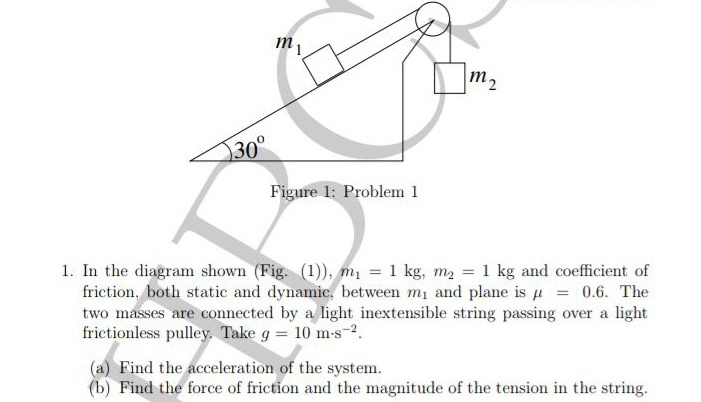Question
Question: In the diagram shown (Fig. (1)), $m_1 = 1$ kg, $m_2 = 1$ kg and coefficient of friction, both static...
In the diagram shown (Fig. (1)), m1=1 kg, m2=1 kg and coefficient of friction, both static and dynamic, between m1 and plane is μ=0.6. The two masses are connected by a light inextensible string passing over a light frictionless pulley. Take g=10 m⋅s−2.
(a) Find the acceleration of the system.
(b) Find the force of friction and the magnitude of the tension in the string.

Answer
(a) The acceleration of the system is 0 m/s2. (b) The force of friction is 5 N (acting down the incline), and the magnitude of the tension in the string is 10 N.
Explanation
Solution
- Calculate the component of gravity down the incline for m1 (W1∥=5 N) and the weight of m2 (W2=10 N).
- Calculate the normal force on m1 (N=53 N) and the maximum static friction (fs,max=33 N ≈5.196 N).
- Assume static equilibrium. For m2, tension T=m2g=10 N.
- For m1 to be in equilibrium, T=W1∥+f (if friction is down) or W1∥+f=T (if friction is up).
- If T=10 N and W1∥=5 N, then for equilibrium, the required friction is f=∣T−W1∥∣=∣10−5∣=5 N.
- Since the required friction (5 N) is less than the maximum static friction (fs,max≈5.196 N), the system remains in static equilibrium.
- Therefore, acceleration a=0 m/s2.
- Tension T=10 N.
- The force of friction is 5 N. Its direction is down the incline, as T>W1∥, indicating a tendency for m1 to move up, which friction opposes.
